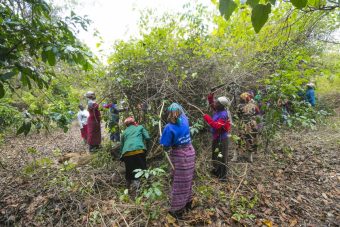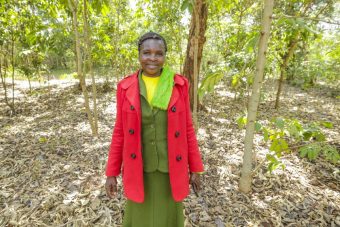When Zipporah Matumbi was growing up, she loved the way the forest in her village in East Kenya had a dense canopy. As an adult, she noticed that with extensive logging, the forest was disappearing. So she gathered a group of women to start tree nurseries, using their own time and money, to save the forest around them and make a difference.

“We wanted our children to be able to grow up in a healthy environment,” she says. “We had seen how the river flows had started to be low and we wanted to bring the water back by taking out the eucalyptus which consume a lot of water and replacing it with bamboo native to Africa.”
Matumbi became part of the Tree Establishment for Livelihood Improvement Scheme, a system that plants indigenous trees for conservation in degraded forest areas. Although similar in name, it is different from Plantations Establishment for Livelihood Improvement Scheme which is about establishing plantations of exotic trees.
Matumbi’s group of women volunteers has grown substantially over the years; she is currently in charge of some 12 different groups. During that time, she has noticed that many forests struggle to grow indigenous trees because of a colonizing shrub introduced from the American tropics called lantana camara.
“Lantana camara has beautiful flowers, but this adaptable plant is highly invasive and causes problems in many tropical countries, crowding out the original flora and even increasing fire risk in dry forests,” says Lera Miles, Principal Technical Specialist for Climate Change and Biodiversity at the United Nations Environment Programme (UNEP) World Conservation Monitoring Centre.

It is also affecting smallholder farms, livestock pasture and roadsides.
So Matumbi and her group started voluntarily helping the Kenya Forest Service dig up the lantana by their roots to suppress their regrowth and prepare the area for rehabilitation by introducing indigenous trees. The indigenous trees don’t grow very fast, but when they have enough space and are carefully pruned, they can do well.
Matumbi knew replanting forests alone would not be enough, so she encourages her members to remove lantana and plant trees on their own farms as well. Pruning those trees for firewood partly relieves pressure on the forest. The same goes for using leftovers from maize, shrubs and leaves as fodder for the cattle so they don’t need to go grazing in the forest, destroying trees. She also brings experts in to train her members on alternative livelihoods such as beekeeping or basket weaving to reduce their dependency on unsustainable forest practices.
“Local communities feel the brunt of the impact by invasive plant species to their livelihood as well as the environmental services such as water supply,” says Max Zieren, UNEP environmental specialist with over 30 years’ experience in environmental protection, community development and forest rehabilitation. “Community initiatives such as the one led by Matumbi show the opportunity offered through shared interest with governments to fight the spread of invasive species—thereby rehabilitating degraded landscapes which is part of the Decade of Ecosystem Restoration.”
Matumbi says she is using free prior informed consent, a United Nations Development Programme initiative introduced under the UN-REDD Programme, to negotiate user rights for her groups of volunteers through the National Alliance of Community Forests Kenya. That group is lobbying for her and a draft policy has been made.
Meanwhile, they keep working tirelessly “for a better environment and therefore a better health for all.”
Source: UNEP





